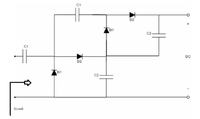Pheezy
Newbie level 4
Hey all,
I intend to calculate the impedance as indicated but I am unsure on how I would do this. The reason I need to calculate this impedance is because this is part of a bigger project where I am trying to match the source impedance with the load impedance and I will need to design a impedance matching circuit for it.
The source is a 50 ohm antenna and this connects directly to this circuit in the given image.

NOTE: The diodes are the BAT46WJ schottky diodes. Essentially its a rectifier with multiple stages.
Any help would be appreciated.
Cheers
I intend to calculate the impedance as indicated but I am unsure on how I would do this. The reason I need to calculate this impedance is because this is part of a bigger project where I am trying to match the source impedance with the load impedance and I will need to design a impedance matching circuit for it.
The source is a 50 ohm antenna and this connects directly to this circuit in the given image.

NOTE: The diodes are the BAT46WJ schottky diodes. Essentially its a rectifier with multiple stages.
Any help would be appreciated.
Cheers
Last edited by a moderator: